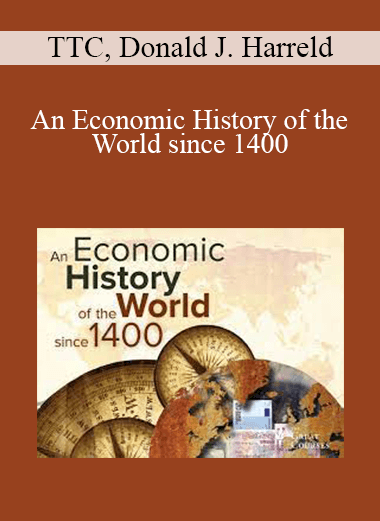An Economic History of the World since 1400
48 Lectures
Course Overview
Money truly does make the world go ‘round. And yet, when it comes to the study of world history, most of us focus on politics, society, and culture. We often overlook the vital importance of economics.
Economics has, in many regards, created the world. Not only is it the process through which societies provide for the well-being of their citizens, it has also driven everything from trade and politics to warfare and diplomacy. In fact, there’s not a single aspect of history that has not, in some way, been influenced by economic practices.
Most of us, even those savvy at following today’s market fluctuations, have a limited understanding of the powerful role economics has played in shaping human civilization. This makes economic history—the study of how civilizations have structured their environments in order to provide food, shelter, and material goods—a vital lens through which to think about how we arrived at our present, globalized moment. It’s also a way to educate yourself about the history behind today’s (and tomorrow’s) economic headlines, from trade negotiations to job outsourcing to financial miracles.
Designed to fill the long-empty gap in how we think about modern history, An Economic History of the World since 1400 is a comprehensive, 48-lecture journey through more than 600 years of economic history, from the feudal system of the medieval world to the high-speed information economy of the 21st century. Aimed at the layperson who has only a cursory understanding of economics, these lectures illustrate the fascinating links between economics and history, revealing how the production, consumption, and exchange of goods has influenced (and been influenced by) historical events and trends, including the Black Death, the Age of Exploration, the invention of the printing press, the Industrial Revolution, the European colonization of Africa, the collapse of the Soviet Union, the rise of China and India, and the birth of personal computing.
How can concepts like prices, resource allocation, production methods, technological development, and labor steer the fates of entire nations and ways of life? In the hands of economic historian and award-winning professor Donald J. Harreld of Brigham Young University, this profound question forms the foundation of an exciting Great Course that transforms the basic economic worries of providing for one’s welfare into a riveting, centuries-long story of power, glory, and ideology.
Discover the Economics behind History’s Great Events
What’s so special about the year 1400? Professor Harreld starts the course here because this was the historical moment in which we first begin to see the baby steps that would send the world toward the modern economic systems we use today. And while the lectures extend outward to examine the economic histories of places like India, China, and Africa, the focus is primarily on the West, because the world economy has been framed by Western ideas and ideals for the past several centuries.
“Economic history is not the examination of the history of economics,” notes Professor Harreld. “We’ll only lightly touch on the history of economic thought. Instead, we’ll focus on what happened in the past—rather than what people thought about what happened in the past.”
An Economic History of the World since 1400 is your opportunity to view major historical moments through the perspective of economics, shedding new light on familiar people and events. It’s also your chance to see how, in step with history, economic ideas emerged, evolved, and thrived or died.
- The Black Death and the end of serfdom: From 1346 to 1353, the plague devastated the population of Europe—an event that would have profound ramifications for the largely feudal economy of the time. Along with a drop in the amount of cultivated farmland and a rise in wages, the Black Death forced indebted manorial lords to turn the management of their estates over to peasants, which began the trend of eliminating serfdom that would be finished by the 19th century.
- Colonialism and joint stock companies: By the end of the 16th century, the Dutch and English broke the Portuguese monopoly on voyages to Asia, opening a new chapter in the story of European domination over long-distance maritime trade. This, in turn, gave rise to joint stock companies—new forms of business organizations like the Dutch East India Company. So powerful were these merchant blocks that their charters acknowledged the use of violence to advance international trade.
- Class consciousness and consumer culture: In the late 19th century, thanks to technological advancements and better living standards, Europeans and Americans had more money in their pockets than ever before. What resulted was a working-class interest in fashions and tastes that had formerly concerned only the upper class. To satisfy this, people turned to more modern forms of consuming goods like mail-order catalogs and department stores. However, an increased emphasis on class lines also led to major labor strikes and riots, as well as the birth of communism.
- World War I and postwar debts: The First World War not only destroyed nations, it also ravaged the international economy. In the years after the war, huge debts that countries had accumulated to finance the war had to be paid off. Inflation hit much of Europe after the United States insisted on being repaid in full. There was also the matter of Germany’s war reparations bill, which was more than $30 billion. Unknown to most parties, these and other economic events created conditions that helped bring about World War II.
- The Middle East and the oil economy: How did the Middle East become such a powerful player on the world stage? The answer lies in the last quarter of the 20th century, when Western attempts to exert economic power in the region, a softening of the post-World War II economy, and a global shift in fuel consumption provided these oil-rich nations with a major role in world affairs.
Examine the Intersection of History and Economics
As Professor Harreld takes you through the tumultuous centuries of modern history, you’ll strengthen your understanding of a range of economic concepts, philosophies, trends, treaties, and organizations.
- Learn how early guilds and monopolies were established in an effort to protect merchants from competition in distant cities.
- See how the mercantile system defined by Adam Smith in The Wealth of Nations helped further the process of state building that would remake Western Europe.
- Discover how the United States, which often borrowed European technologies, pioneered the American system of manufacturing using interchangeable parts in the 19th century.
- Consider how Marxist economic ideas played a major role in the African independence movement (and the Cold War) during the 1950s and 1960s.
- Witness how various nations came together to form international economic organizations, partnerships, and trade blocs including the European Union, the Arab League, and NAFTA.
By grounding these and other topics in the history of world events, An Economic History of the World since 1400 makes them much more understandable. It also cements the important role the economy played in why wars were won (and lost), why international agreements were made (and broken), and why national economies rose (and fell).
Professor Harreld also invites you to consider provocative questions about the intersection of history and economics—and their illuminating answers.
- What technological invention, more than any other, revolutionized the modern economy?
- How do economic historians define terms like “globalization” and “class consciousness”?
- Why didn’t China’s advanced civilization industrialize hundreds of years before it actually did?
- What did the economies of Roosevelt’s America and Hitler’s Germany have in common?
- What does history tell us about how nations should—and shouldn’t—dictate economic policy?
- Can we say that free trade is truly free?
Marvel at History’s Economic Forces
An award-winning teacher and chairman of Brigham Young University’s Department of History, Professor Harreld has spent his career carefully analyzing the interplay between economics and the social and political behavior of countries throughout the world. His chronological approach to the subject, combined with illuminating visual aids (including detailed maps, historical documentation, and illustrations of key trade routes) make this an excellent visual learning experience. And his resonant, authoritative voice makes these lectures equally compelling to hear.
While it may seem daunting to chart the economic evolution of the modern world, in the hands of this master educator, you’re never overwhelmed or vexed by complex economic details. Instead, you’re guided through a top-level explanation of economic concepts, with the focus always being on their historical ramifications.
“History doesn’t repeat itself exactly,” says Professor Harreld. “The world changes. But the past helps us see the world today more clearly.” With An Economic History of the World since 1400, marvel at just how much we still have to learn about the economic forces that have dictated our past—and that will undoubtedly dictate our future.
Get download TTC, Donald J. Harreld – An Economic History of the World since 1400 at coursesblock.com right now!
Delivery Method
– After your purchase, you’ll see a View your orders link which goes to the Downloads page. Here, you can download all the files associated with your order.
– Downloads are available once your payment is confirmed, we’ll also send you a download notification email separate from any transaction notification emails you receive from coursesblock.com
– Since it is a digital copy, our suggestion is to download and save it to your hard drive. In case the link is broken for any reason, please contact us and we will resend the new download link.
– If you cannot find the download link, please don’t worry about that. We will update and notify you as soon as possible at 8:00 AM – 8:00 PM (UTC 8).
Thank You For Shopping With Us!







